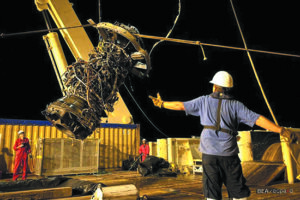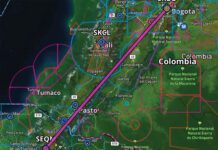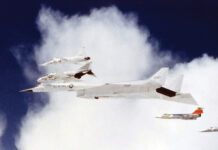If you ask a pilot, “Have you ever panicked while flying?” and they respond, “No,” watch them closely. They’ll probably lie to you about other things, too. Speaking for myself, the times I experienced panic were a little more, uh, “justified,” maybe, and they hit me right quick.
Just what is this thing called “panic?” What happens if you do panic? And how can you not panic to start with?
Even Famous Pilots Panic
Let’s look at a famous pilot who panicked. This was back before he was famous, in the 1800s.
The young, still-learning “cub” steamboat pilot was Samuel Clemens. Perhaps you’ve heard of him. Yes, Mark Twain.
Twain’s pilot boss played a trick on him to teach him a lesson on how to overcome panic. He conspired with the “lineman,” who called out the river depths, and had the lineman falsely call out, “Shallow water!” in an area Mark Twain knew was very deep.
Even though Twain knew the water was very deep there, hearing that false “shallow water” call, he panicked. He thought the boat was going to hit the bottom, and yelled into the speaking tube to the engineer, “Oh, Ben, if you love me, back her! Quick, Ben! Oh, back the immortal soul out of her!” There was no danger of course—the river was plenty deep there. Twain had to put up with people mocking him for panicking for some months after that. Overall, it was a very good lesson on how to tamp down that terrible panicky feeling and think, he figured, though he wasn’t fond of the ribbing.
Panic is real, as real as can be. Panic takes over the mind in an instant, and rational thought is gone. According to Merriam-Webster, panic “implies unreasoning and overmastering fear causing hysterical activity.”
Much of the FAA’s guidance on the general term “panic” is devoted to very real aeromedical concerns like anxiety. In fact, the current Airplane Flying Handbook (AFH) contains just three instances of the word, each of which is associated with responding to an in-flight emergency.
In one of those instances, the AFH notes that, “when fear leads to panic, we invite that which we want most to avoid. The survival records favor pilots who maintain their composure and know how to apply the general concepts and procedures that have been developed through the years.” In other words, follow your training:
Aviate, Navigate, Communicate. No matter the problem, you still have to fly the aircraft, navigate it to a safe landing and communicate the situation to your crew, your passengers and ATC.
Use The Proper Checklists. The answer to resolving the emergency may be in the checklists tucked away in a map pocket by your left knee. They provide step-by-step instructions on how to address the emergency.
Training. Practicing for emergencies includes keeping the aircraft in the air and pointed where you want it to go, plus configuring it via the appropriate checklist procedure. Comprehensive training likely means you will have already experienced the emergency situation and know how to respond to it by performing the procedures you’ve already practiced.
Knowing what to do ahead of time helps prevent the kind of in-cockpit panic that can lead to “paralysis by analysis” and other undesirable human factors. — J.B.
There I Was…
I remember this like it was yesterday, but it was 1987. I was a student flying a T-38 Talon on a night solo, returning to Vance Air Force Base. The base had switched runways from Runway 35 to Runway 17, so that when I came back into the base I was approaching the traffic pattern from the north. Of course. But I somehow had it fixed in my mind that I was approaching from the south, to Runway 35. Never mind the instruments that showed me flying south.
As I approached the base, “from the south,” I looked to the right of the runway for the familiar lights of Vance Air Force Base—the roads, the housing area, the lit-up parking lots, etc. All I saw was blackness. What?! How can that be? I searched the black Oklahoma ground madly—I could see the runway no problem, well lit-up in the dark.
I started to panic: I was going to be over the runway in seconds but there was no Vance Air Force Base nearby. Impossible. I couldn’t see any lights to the right of the runway, and the base should be to the right of the runway. Where are the houses and the roads? How can this possibly be? I was frantic for a few long seconds, which felt longer. Then relief and embarrassment both. There’s the base—which some called the little prison camp on the prairie—where it had to be.
Do I use the instruments big-time now, even in VMC conditions? Yeah, you betcha I do. (I never told anyone about that episode, so keep it under your hat.)
There I Was…Again

Another time I was out flying the T-38 as a solo student, once again coming back to base. There was a solid cloud deck at maybe 6000 feet that ended a few miles from the base. Cool, I thought, and flew just a few feet above the deck and slapped the stick to the right.
Now the T-38 would roll twice per second, a 720-degree-per-second roll rate, and I aileron-rolled it five or six times right over the cloud deck, the coolest visual ever, and then rolled out. My head was swimming from the rolling, my “gyros tumbled.” I saw only the white cloud deck beneath me, and where the heck is Buffalo, the VFR entry point ground reference?
I panicked a bit, breathing quickly, rocketing along over a solid white sheet. Shucks, 45 more seconds at this speed and I’ll blow right past the VFR entry point, right into the center runway approach, and then on to Arkansas. Then I suddenly thought, “Ask for vectors, dummy!” I keyed the mic and asked ATC for “vectors to Buffalo.” No one did that, by the way.
Buffalo was straight ahead, about eight miles, it turned out, and I got vectored there. My classmate ribbed me about it on the ground. I deserved the taunting; doing aileron rolls like that and getting discombobulated was my own fault.
What About You?
How will you deal with panic? We never know until we experience it. For example, soldiers in the U.S. Civil War were found dead on the battlefield after a fight, some of their rifles loaded six and seven times, one load tamped down on top of the other. They panicked as the other side attacked, bugles blowing, flags flying, men yelling, guns and cannons firing. The rifles were jammed up solid and couldn’t be fired. On the other hand, one can read about “battle-hardened soldiers” in various war stories. The ones who learned not to panic stayed calm under fire.
“I’ve never panicked, never will,” a person might say, sitting in a chair at home. Oh, really? Everyone who has ever panicked was sitting at home at one time. Sitting at home and not in the Civil War, or getting attacked by a shark, or seeing, say, their child chase a ball right into a busy street.
At Beale Air Force Base, California, I had to do what was called “recurrent water survival training.” We wore flight suits, tennis shoes and helmets, jumped off the diving board and came up underneath a parachute that was stretched taut across the swimming pool surface. The idea was to enter the water and come up underneath the ‘chute, making an air pocket. Then trace a riser to the edge of the chute. Just like we were briefed to do—make an air pocket, trace a riser. Simple. Then it happened.
A trainee came up under the parachute in the deep end and started screaming. The safety airmen dove into the pool under the parachute lightning-quick, grabbed her and got her to safety. She was spitting water and sobbing a bit. I was next.
I jumped into the deep end of the pool feet-first, came up under the canopy, and pushed up to make an air pocket to breathe in, and started to breathe in. Only there was no air pocket. When I pushed up on the parachute, I didn’t break the surface. Instead of the parachute moving up, I moved down.
Thinking I had created a pocket of air, I breathed in. Let me just say, “breathing” water and “drinking” water are very different. I panicked—right now. Big time. Never been so scared. The worst panic I ever felt, or close to it. (The “It’s going into Mach tuck!” episode going 0.99 Mach in a KC-135Q gets honorable mention.)
My mind raced, and I thrashed my arms and kicked my legs and pushed back up on the parachute as hard as I could. It went up off the pool surface, creating a small air pocket under the orange and white fabric, and I stuck my head into the air and coughed and gasped and spit and breathed in air, this time. And out, and in. I was okay! Whew!
So if I ever parachute into water, which, let’s see, let me check my schedule—nope, no immediate plans to do that in the next million years—I do have that training, scary as it was.
When Pilots Panic

Let’s look just a bit at two ugly crashes: Atlas Air Flight 3591, on February 23, 2019, near Houston, Texas, and Air France Flight 441, June 1, 2009, over the Atlantic Ocean. A person can read all about them on the Internet, which I’ve done, and have been guilty of thinking, “I would never do that!”
The pilots—some, not all—in both crashes panicked. Remember how panic overrides thinking? And remember that these are only two episodes. Two, out of all the flying done so far in the world, just two “real-world” panic stories. Be assured there are others.
From the black boxes we hear things like, “Oh. Whoa! My speed my speed? Lord help me!” on the Atlas flight, with the jump-seater yelling, “Pull up!” On Air France, one pilot: “I don’t have control of the aircraft anymore!”
I must remember that I am perfectly capable of panicking—I’m not immune to it. But if I practice the aircraft emergency procedures, over and over, so they are second nature, then if—when—something happens, take rapid decompression (please)—I’ll hopefully be ready and calmly deal with the “something,” like a scary “rapid D,” and slap that quick-donning oxygen mask on my face.
Panic. It’s no joke, though I do love to joke around. Oh, and before I forget, please don’t tell anyone about me in the pool. My scream was internal, so it doesn’t count.
Matt Johnson is a former U.S. Air Force T-38 instructor pilot and KC-135Q copilot. He’s now a Minnesota-based flight instructor.




